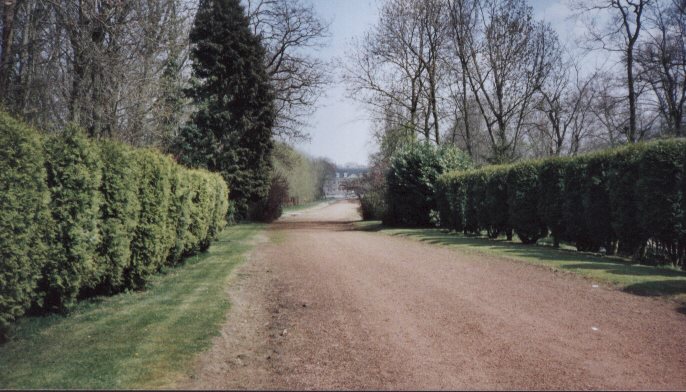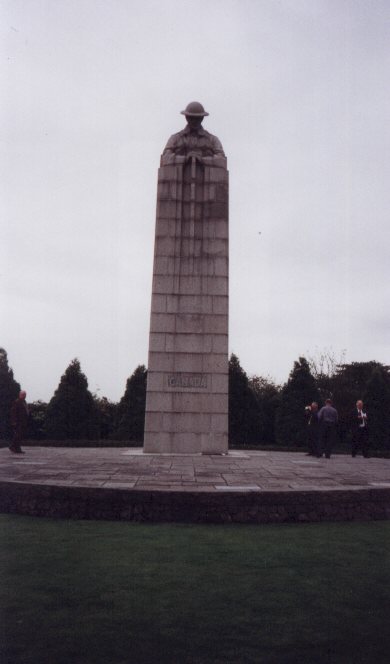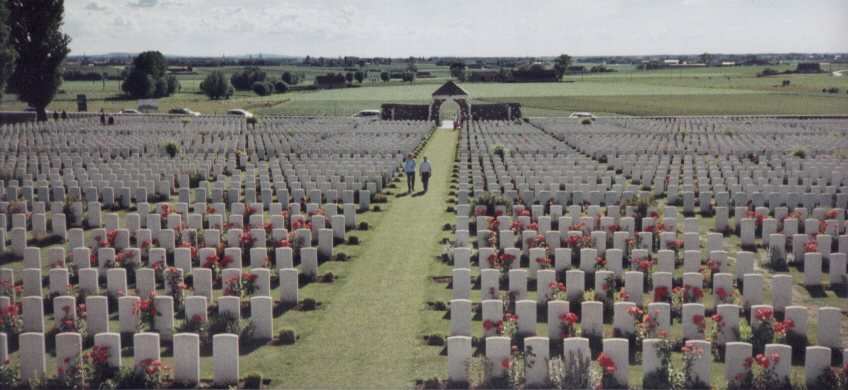 Chateau at Gheluvelt, scene of the 2nd Worcesters attack
Chateau at Gheluvelt, scene of the 2nd Worcesters attackTimeline - October - November 1914
Background - The BEF had fought for two months and reached a stalemate on the Aisne, over a front of 26 miles. They had lost 36,000 men, and the Army stood at nearly 164,000. For several reasons - short supply lines etc: it was decided to move North to initially support a small force at Antwerp. 1st Corp (Haigh) was the last to leave on the 19th October and so the famous Salient started to form, and the race to the sea began. The British aimed to drive Germany out of Belgium whilst Germany coveted the Channel Ports and if they cut the British off from their supply lines, they would surrender and Germany would be free to overrun the rest of France. The fighting started around La Basse on the 12th October and steadily moved northwards each side trying to out flank the other.
Special Points of Interest - Ypres was the first big prize as it was a vital communications centre. The small Belgian Army held the North of Ypres to the sea and at the end of October opened sluice gates at Nieuport, flooded the low plain and stopped the German advance. 22nd October was the day the big German offensive began to take Ypres & Calais. The two main attacks were in the areas of Langemark and Gheluvelt. The BEF were supported by some French Troops and the Lahore Division Indian Troops. On the 31st October the Germans captured Gheluvelt, but were repulsed by the famous counter attack of the 2nd Worcesters. This action I believe, stopped the war "ending by Christmas" as there were no other reserve troops between them and Calais. Some units ie. the Loyal North Lancs were reduced to 35 men and 1 officer. In the heavy fighting in this area, the Germans had a superiority of 6 to 1.
Memorials and Cemeteries
ZILLEBEKE CHURCHYARD - Only 32 graves, majority officers. Lt Steere has a special memorial here, and 2nd Lieutenant Baron Alexis de Gunzburg who was Russian, born in Paris, educated at Eaton, became a naturalized British Citizen and enlisted. Killed 6th November 1914 is also buried here
POPERINGHE NEW MILITARY CEMETERY - Started during 1st Ypres but now "famous" for a high concentration (17) of burials of "Shot at Dawn" casualties.
KEMMEL CHURCHYARD - Contains the grave of Major GGP Humphreys, 129th Baluchis Indian Army. KIA 30th October 1914, fought in Uganda, China and Delhi
WULVERGHEM CHURCHYARD - Due to heavy shelling in April 1918 most of the 1914 graves were lost and have now been replaced by Special Memorials, one of them being that of Squadron Sergeant Major HW Baker, 11th Hussars, killed on the Messines Ridge 30th October, with over 20 years service in the Army
RIFLE HOUSE CEMETERY (In Plugstreet Wood) - This cemetery has some 1914 burials, one from December (not 1st Ypres) is Reuben Barrett aged only 15
LANCASHIRE COTTAGE CEMETERY - The cemetery was started in November 1914 by the 1st Bn East Lancs. Many early burials were in local churchyards where they remain to this day
THE PLOEGSTEERT MEMORIAL AND THE MENIN GATE - These are the two main sites for casualties with no known grave. Do not miss the Last Post at 8pm each evening at the Menin Gate
Additional Information - The Kaiser was at the Ypres front on the 31st October expecting to make a triumphal entry into the city. Whilst the heavy fighting took place on the 31st a stray heavy shell hit the 1st Division HQ at Hooge Chateau and wounded Major General Lomax, the Commander and killed all other officers except one. Nonneboschen Wood was the nearest the Germans got to Ypres and after being beaten back by the 2nd Ox & Bucks LI, fighting slowed until it ended on the 17th November. This battle effectively destroyed the British standing army with losses of over 58,000. The German casualties were said to be over 135,000 and they were possibly double this, as Germany refers to this battle as Der Kindermord bei Ypern, the Massacre of the Innocents at Ypres. On the 22nd November Britain "officially" declared war on Germany
Second Ypres
 The Brooding Soldier, Canadian Memorial of the first gas attack
The Brooding Soldier, Canadian Memorial of the first gas attackTimeline - 5pm April 22nd - May 4th 1915
Background - One of the few times the Germans made an attack on the British lines. The British were suffering from a shortage of trained men and supplies, mainly artillery
Special Points of Interest - The first use of gas. The Germans attacked from the North Eastern area of the Salient towards St Julian, Langemark and the Yser Canal in the Het Sas area. The attack was aimed at breaking through the Allied lines and striking towards the coast. 6,000 gas cylinders of chlorine were prepared for the attack directed at the French held sector. Chlorine is heavier than air and is a lung & eye irritant, inhaled enough it can be lethal. This first use of gas relied on wind direction and the late hour it was released (5pm) and the lack of clear orders to the attacking German troops helped the Canadians to move men quickly and plug the almost two mile gap in the Allied lines. A second release of gas took place at 3am on the 24th due east of St Julian which resulted in more loss of ground around the Salient. The "front" now rested on the Frenzenburg Ridge.
Memorials and Cemeteries - Three Memorials have been erected commemorating this action. The most famous is the imposing "Brooding Soldier" at Vancouver Corner, just North of St Julian. This marks the battlefield where the Canadian forces lost 2,000 men. Near the Yser Canal at Boesinghe the French are remembered by an authentic Breton Calvary at Carrefour de la Rose. The third Memorial at Streenstraat is a Wooden Cross which replaced the original stone memorial destroyed during WW2 by the Germans who objected to its inscription. There are many cemeteries spread over a large area, used to bury the casualties from this battle. Some of the main ones being:- Essex Farm, famous for the site of Colonel John McCrae who wrote the poem "In Flanders Fields" here. Talana Farm, started by French Zouaves has many burials from this action. No less than four cemeteries are in the locality of Potijze all started in early 1915. At the Seaforth Cemetery Cheddar Villa, lie many British who died on this spot 25/26 April. Nearby is a large bunker incorporated into some farm buildings
Additional information - Seven VCs were won in fighting in this area, four from the Canadian 1st Division, one by the British 4th Division and two by the Lahore Division. The unpopular and unreliable Ross .303 Rifle was used by the Canadians in this action. It was not completely replaced with the standard British Lee Enfield until 1916.The Brooding Soldier is a must see and quite near to the Tyne Cot area. The Breton Calvary is also very different and not too far from Essex Farm. Here there is a special memorial to McCrae and some original concrete dugouts used for various functions including a latrine, See if you can "spot" this one. Around Essex Farm is also the Diggers area. This now disbanded group, performed sterling work unearthing many lost casualties and giving them a proper resting place, as well as uncovering and restoring some trench lines in the canal area. They will be missed
Third Ypres
 Tyne Cot Cemetery, Passchendaele
Tyne Cot Cemetery, PasschendaeleTimeline - 7th June 1917
Background - The Salient was at its smallest size, from Boesinghe in the North the loop was less than 2 miles down the Menin Road, down to Hill 60 and bulged around Wytschate and Messines down to Ploegsteert Wood. The campaign actually started early in 1916 when engineers began to dig underground a series of tunnels. The plan was to blow the Germans off the Messines Ridge and allow an attack to the North West to reach the coast via Passchendaele and capture Ostend to stop the U Boats, which were sinking thousands of tons of shipping weekly.
Special Points of Interest - The battle, 3rd Ypres often just called Passchendaele was fought in two stages. The Southern ground Ploegsteert Wood to Hill 60 was started when 16 mines were exploded and the Messines Ridge taken. Many of these mine craters still exist at Spanbrockmolen, St Eloi, Petite Bois and Factory Farm which can be visited. All have their own individual stories but the most infamous ones are the ones which didn't go up in the Ploegsteert area. One of these did explode in 1952 but two are still missing, one in the locality of Petit Douve Farm. After a delay of six weeks (with good dry weather) the Northern campaign started on July 31st. From Zillebeke to Hooge upto Wieltje and across to Boesinge the Fifth Army attempted to emulate the succesful action of the Fourth. Early advances were made up the several ridges before Passchendaele, until nature intervened with rain. That, coupled with the heavily shelled ground turned the whole low battleground into a sea of mud and holes filled with water. The ridge was not secured until 10th November 156 days after it started. A quarter of a million men were casualties in the previous 3 months 90,000 "missing" and 42,000 bodies never recorded. Many of these are still there buried in the mud.
Memorials and Cemeteries
TYNE COT AND THE MEMORIAL TO THE MISSING - This is the largest British Cemetery in the world, mainly due to large scale battlefield clearances it has 11,900 graves centered on the largest of three German pillboxes which became a dressing station. The view backwards towards Ypres shows the outstanding observation the Germans had. The cross is mounted on a bunker as suggested by King George V
PASSCHENDAELE NEW BRITISH CEMETERY - Another concentration cemetery. many Canadians and Australians buried here. Pvte A. Decoteau, an Indian from the Red Pheasant Reserve was killed by a sniper on 30th October. A typical tribal burial was held to lay his spirit to rest
DOCHY FARM NEW BRITISH CEMETERY - Another concentration cemetery. Two thirds of the 1,450 burials are unknown, all of the Allied Armies are represented here
NEW ZEALAND MEMORIAL AT GRAVENSTAFEL - This memorial is on the Weitje to Passchendaele Road, mainly commemorating the fighting on the Broodseinde Ridge, October 1917
CREST FARM - Captured by the 72nd Battalion CEF. One of a series of simple memorials on the Western Front where the Canadians fought
Additional Information - We are all attracted to the magnet of Tyne Cot, it's size is almost overpowering and is another must see site. This battlefield is not easy to visit as the burials were mainly concentration sites so there is some loss of intimacy unlike other battlegrounds like the Somme. Polcapelle and Langemark cemeteries are both worth a visit. At the latter you can observe a typical German burial site (with some original bunkers), compare it to the British ones. Most of the ground won so expensivly was lost in a few hours during the German Spring Offensive 1918. In an area near Wieltje is a dugout that was used as an first aid post by Captain Noel Chavasse VC. On the 2nd August 1917 he was himself wounded bringing in wounded men and died at nearby Brandhock Casualty Clearing Station, winning his 2nd VC. The only person in WW1 to achieve this. This is now a cemetery and is another much visited site on the Ypres to Poperinge Road